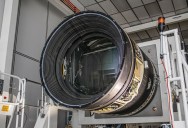Meet The World’s Largest Digital Camera That Boasts A 5-Foot Lens And Weighs 6,600 Pounds

For a long time, the people who developed new tech tried to convince us that smaller was better.
It has to fit in the palm of your hand!
Now, though, we’re going to opposite direction and this digital camera is the biggest one yet.
It’s called the Legacy Survey of Space and Time (LSST) Camera and will soon travel to the Vera C. Rubin Observatory.
There it will keep eye on the southern sky and help answer questions about the nature of dark matter and energy.
TIL the resolution of the human eye is 576 megapixels.
the iphone 14 pro is 48.
a new camera called Legacy Survey of Space & Time (LSST) camera will have 3200 megapixels, destined for La Silla observatory in the Atacama Desert in Chile.
(photo credit @jacqramseyer) pic.twitter.com/pk0YWufxZN
— Preston Pesek (@prestonpesek) April 7, 2023
It is 3200 megapixels and weighs 6,600 pounds. The images it produces are so large that it would take 378 4K televisions in a grid to be able to properly see them.
Željko Ivezić, the Director of Ruin Observatory Construction, says it’s almost beyond comprehension.
“With the completion of the unique LSST Camera at SLAC and its imminent integration with the rest of the Rubin Observatory systems in Chile, we will soon start producing the greatest movie of all time and the most informative map of the night sky ever assembled.”
The camera has one 5-foot lens and one 3-foot lens that have been custom designed. The second one is used to seal the lens’ focal plane, which is kept in a vacuum.
For the non-photogs out there, the focal plane is the heart of the camera. It’s made of 201 CCD sensors that are custom made, and each pixel is 10 microns wide.
The focal plane is so flat that its surface doesn’t vary by more then one-tenth of the width of a human hair.
It all combines, says Rubin Observatory Deputy Director and Camera Program lead Aaron Roodman, to create a revolutionary resolution.
“Its images are so detailed that it could resolve a golf ball from around 15 miles away, while covering a swath of they sky seven times wider than the full Moon. These images, with billions of stars and galaxies, will help unlock the secrets of the Universe.”
SLAC National Accelerator Laboratory, United States.
Circa 2021.
SLAC's LSST (Legacy Survey of Space & Time) team carefully unpack, examine, test and store the r-band filter, the first of six optic filters that will be part of the completed LSST Camera. pic.twitter.com/NtHuAhSzqA
— Engineering Aesthetics (@eng_aesthetics) August 19, 2023
The Rudin Observatory plans to study how galaxies and clusters of galaxies have changed over billions of years. They hope this will provide insight as far as how galaxies evolve.
It will also measure supernovae and help us better understand the dark energy at the center of our universe’s expansion.
And sure, it could pick up some never-before-seen asteroids.
It’s set to power up in January 2025.
I, for one, can’t wait to see the pictures.
If you enjoyed that story, check out what happened when a guy gave ChatGPT $100 to make as money as possible, and it turned out exactly how you would expect.

Sign up to get our BEST stories of the week straight to your inbox.




